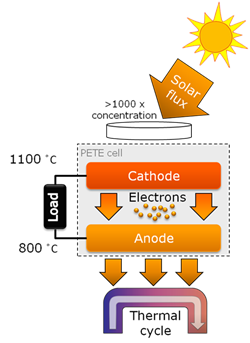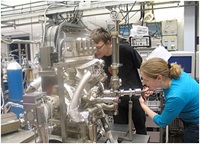Electro mechanical energy harvesting for wireless electronic devices
(See description here)
Photon-Enhanced Thermionic Emission Solar Cells
High efficiency solar cells are of critical importance if the ambition of a future powered by renewable energy sources is to be realized. Today, multi-junction solar cells have exceeded the Shockley-Queisser limit of the conventional single material pn-junction solar cell by reaching efficiencies of approximately 43%. However, the fundamental thermodynamic limit for a general solar cell, known as the Landsberg limit, is at 93.3% almost twice the current obtainable efficiency. Thus, a large efficiency potential is today still unrealized. This is partly due to the fact that most solar cell designs today rely on the conversion of photon energy into electrical energy by photoexcitation in a band gap design, where energy in excess of the bandgap is wasted through thermalization. In the photon-enhanced thermionic emission (PETE) design, however, excess photon energy remains accessible as it is used to heat up a thermionic emitting semiconductor. Since the thermionic current increases with temperature, both the direct photon excitation energy as well as the excess thermal energy adds to the output power. Also, an extra thermoelectric machine in series with the anode allows for a tandem setup that further improves efficiency. In order to realize a PETE solar cell several enabling technologies have to be developed, including high temperature low work function surface modifications, high temperature and high power contacts and high mechanical stability at elevated temperatures.


(Left) Concentrated solar light is incident on a semiconductor cathode. The energy required for electrons to cross the energy barrier between cathode and anode is obtained from both the energy acquired in the photo excitation across the bandgap and from the thermal reservoir of the cathode. An additional thermoelectric engine at the anode helps increasing efficiency further. (Right) UHV setup for characterizing the solar cell surface properties.
Nanostructured Solar Cells
By using reactive ion etching (RIE) nanostructures can be formed on the surface of Si in a simple, maskless 1-step process. Since these nanostructures are known to create a very anti-reflective surface when fabricated correctly, such a simple fabrication method could be a promising treatment for Si photovoltaics that indeed require excellent anti-reflective properties.
Several different batches of functioning solar cells treated with RIE as texturing have been fabricated in a B.Sc. (2009-10) and M.Sc.-thesis (2011-12) laying out the basis for the current research. So far, the nanostructures have been successfully incorporated in a working Si solar cell with decent power conversion efficiency. The optical properties have been confirmed to be superior to state-of-the-art Si solar cells achieving total weighted reflectance below 1% averaged over the whole solar spectrum (≈300-1150nm). The efficiency is still not superior to the conventional, KOH-textured reference cell and it has been found that the efficiency problem is primarily due to surface recombination. Thus, the current work focuses on better passivation and chemical post-treatments of the “nano-grass” or black silicon. RIE-texturing has the advantage compared to industrial standard texturing that it is able to texture mono-, quasi-mono and multi-crystalline Si. Since all are important in the solar industry, all three kinds of black silicon solar cells are currently being processed. Furthermore thinner solar cells are being fabricated in an attempt to take advantage of the superior light trapping properties of black silicon.

Reactive Ion Etching (RIE) is used to etch nanostructures into the Si surface. The nanostructures significantly increase the scattering of the light at the surface and thus increase the absorption of light – the surface becomes black! The increased light absorption of Si is a desired and important property for Si solar cells, in which increased absorption of sunlight can lead to increased efficiency.